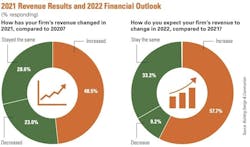Nonresidential construction spending was still stuck in neutral last fall. But more than two-fifths of architects, engineers, and contractors polled recently about their businesses report having stellar years in 2021 despite intensified competition, and look forward to more gains next year.
The value of nonresidential construction put in place in September, the latest month for which data were available at presstime, stood at $814.2 billion, 2.0 percent above the same month a year earlier, according to the Census Bureau. Spending on public safety and office projects alone was off 29.7 percent and 33.9 percent, respectively.
Caulfield is senior editor of Building Design+Construction
Census’ estimates, however, were at odds with the generally positive, albeit anecdotal, attitudes about business conditions that jump out from the responses of 198 AEC firms that BD+C surveyed in late September through mid October—44.4 percent of which rated 2021 as being an “excellent” or “very good” business year. Nearly half of the respondents (48.5 percent) said their firms’ revenue was up this year. Such encouraging numbers no doubt led most respondents (57.7 percent) to forecast that 2022 would be an “excellent” or “very good” year as well for their companies.
Architects accounted for 46.5 percent of those polled, contractors 18.7 percent, and engineers 14.6 percent. The rest were developers, consultants, property managers, and specifiers. Nearly eight in 10 firms polled said their businesses were fit, financially. However, the survey’s participants expect revenue and profit to be under duress from materials prices that 73.2 percent of those polled said will continue to rise in 2022. An even greater portion of respondents—78.3 percent—is girding for bid price hikes next year, too.
Price increases, along with general economic conditions and competition, were cited by respondents among their most critical concerns. And the coronavirus pandemic, despite showing signs of abating in the U.S. in recent months, still lurked as a potential business threat for more than one-third of the survey’s respondents.
When asked what business strategies they planned to deploy over the next year or two, more than half of the AEC firms polled (54.6 percent) said they would make “selective hires” to enhance their companies’ competitiveness. Another 48.1 percent said they planned to make investments in technology, and 47.5 percent intend to strengthen their staff training and education.
Although the AEC industry continues to consolidate, only 10.4 percent of those polled said their growth strategy would include mergers or acquisitions. And don’t look to this industry for social media flag wavers: Although LinkedIn and Facebook are valued tools, more than one-fifth (21.4 percent) of respondents said their firms weren’t using social media at all.
Healthcare, multifamily upsides
AEC firms were asked to assess the prospects for 18 building types. Their answers varied widely and depended on whether their practices extended to a given sector. (For example, the question about airport construction wasn’t applicable for 53.6 percent of 181 respondents; 37 percent of 181 respondents aren’t active in the construction of sports/recreation buildings.)
Read the complete industry report in 2022 Annual Report & Forecast.
That being said, certain typologies stood out, for better or worse:
Nearly three-fifths of 180 respondents (57.2 percent) viewed the prospects for Healthcare/Hospital construction as “excellent” or “very good.” Multifamily construction—whose seasonally adjusted year-over-year starts rate rose in October by 34.0 percent to 528,000 units, according to Census Bureau estimates—was seen by 58.5 percent of our survey’s respondents as having “excellent” or “very good” prospects. About half of 180 respondents also expressed high expectations for the Industrial/Warehouse sector.
On the flip side, the Retail/Commercial sector was seen as “weak” or “very weak” by 38 percent of 179 respondents. The Office sector appeared even more dire to the 39.4 percent of 180 respondents that deemed its construction prospects “weak” or “very weak.” (Office interiors, however, were another matter: 27.1 percent of 181 respondents saw this sector’s prospects as “excellent” or “good,” and another 42 percent thought they were “average.”)
The road to recovery for Hotels/Hospitality might take a while longer to travel, according to the more than half of AEC respondents that saw this sector’s construction prospects as either “average,” “weak,” or “very weak.” Surprising, however, was the ambivalent expectations about such in-demand typologies as Data Centers and Science + Technology buildings. While 41.4 percent of 180 respondents forecast Data Center construction prospects as “excellent” or “good,” 25.6 percent shrugged with an “average” rating. As for S+T, nearly two-fifths of respondents (39.8 percent) rated it “excellent” or “good,” and 25.4 percent rated it “average.”
